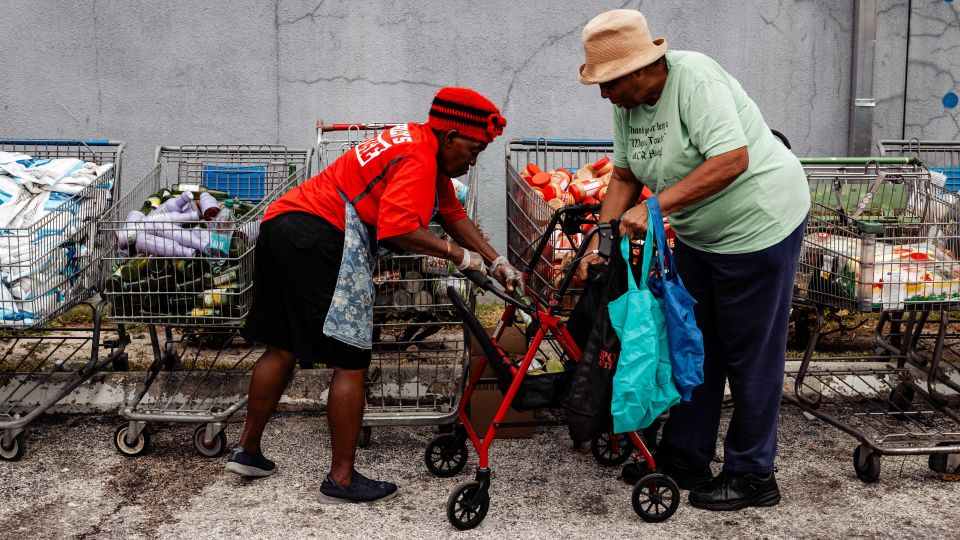Tens of millions of Americans who rely on the nation’s largest federal food assistance program have been caught in a weekslong swirl of Trump administration pronouncements, court orders and anxiety since the US government shutdown has called their ability to buy groceries into question.
Some recipients of the Supplemental Nutrition Assistance Program, or SNAP, the program formerly known as food stamps, have received their full benefits this month, while others have only received a fraction of their usual allotment, while still others remain in limbo, uncertain if or when their payments will arrive.
In response, a group of Democratic-led states and a coalition of cities, nonprofits, unions and small businesses have launched fast-moving legal challenges seeking to restore full benefits.
The fight over food benefits has become a central flashpoint between all three branches of government during the historically long shutdown as one of the clearest and most tangible ways the impasse is affecting Americans’ daily lives.
A sign advertises that WIC and Food Stamps are accepted at a convenience store in Chelsea, Massachusetts, on October 24, 2025. – Brian Snyder/Reuters
While a bipartisan Senate deal has emerged to fund the government through January 30 and ensure SNAP benefits through fiscal year 2026, the successful procedural vote is only a first step. The measure must still pass the full Senate and the House before heading to the president’s desk.
At stake is critical assistance nearly 42 million people rely on to feed themselves and their families. On average, households receive about $350 a month in benefits.
Here’s where things stand:
It is unclear when all SNAP recipients will get November benefits
It is still unclear when all recipients will receive their full allotment for November.
Much depends on when – and whether – Congress actually approves a short-term spending package to temporarily fund federal agencies and reopen the government, and whether President Donald Trump signs it, which could take several more days to play out.
If the deal falls through and the government remains shuttered, exactly how SNAP gets funded in the short term will continue to play out in the courts.
At issue now is a lower court ruling ordering the US Department of Agriculture – which administers SNAP funds on the federal level – to swiftly issue full food stamp benefits to all recipients. Supreme Court Justice Ketanji Brown Jackson temporarily halted the lower court ruling on Friday evening, to allow the appeal to play out.
Late Sunday, the First Circuit Court of Appeals declined a request by the Trump administration to block the lower court ruling, but the ruling has no immediate effect because Jackson’s temporary hold remains in place.
Even after funding is decided and the USDA directs states to provide enrollees with their usual allotment, the timing of the benefits arriving will depend on the state: Some will be able to act immediately, while others may need more time.
Some states have already issued partial or full benefits
After a federal judge in Rhode Island ordered the USDA to pay full SNAP benefits – and the agency issued guidance on Friday saying it was complying – several states rushed to distribute to recipients their full November allotment.
Wisconsin, Pennsylvania, Kansas, New York, Massachusetts, California, Michigan, Colorado, New Mexico, Connecticut, Minnesota, New Jersey, Rhode Island, Washington and Oregon are among the states to issue full SNAP benefits to at least some of their residents in recent days.

Members of the National Guard pack food at a Los Angeles Regional Food Bank facility, as nearly 42 million Americans face a potential lapse in Supplemental Nutrition Assistance Program (SNAP) benefits, known as food stamps, due to the second-longest U.S. government shutdown, in Los Angeles, California, on October 29, 2025. – Daniel Cole/Reuters
Several states have said they will not seek to undo those distributions, as ordered Saturday by the USDA. The states argue they issued the full benefits before Jackson’s pause.
North Carolina, meanwhile, issued partial benefits to recipients on Friday but has halted further action in light of Jackson’s stay.
A weekslong series of court orders put millions in benefit limbo
At the heart of the turmoil is whether the USDA must pay full SNAP benefits without new funding from Congress and if courts can force the agency to fund the program during the shutdown.
Last month, the USDA said it would not use its roughly $5.3 billion contingency fund to provide at least partial payments for November. Full benefits for November are expected to total around $8.2 billion and other expenses push the total cost to nearly $9 billion.
Lawsuits surfaced against the Trump administration, and on Halloween, two federal judges rejected the agency’s claim the contingency fund was untouchable and said the administration was required to tap into billions of those dollars to at least partially cover food stamp benefits in November.
Days after the administration committed to providing 50% – and then 65% – of the maximum allotments at the order of a federal judge in Rhode Island, the judge then said the government must immediately pivot to fully cover SNAP for tens of millions of Americans because some states might not be able to send partial payments for weeks or even months.
“People have gone without for too long,” US District Judge John McConnell said during a hastily called hearing Thursday. “Not making payments to them for even another day is simply unacceptable.”
Hours later, the Trump administration filed an appeal seeking to stay McConnell’s decision. Still, the USDA announced Friday it was working to fully fund food stamp benefits for November to comply with McConnell’s order.
That evening, Jackson granted the administration’s request for a temporary pause, saying the government did not have to immediately transfer additional funds to provide full benefits.
Jackson’s order does not resolve the underlying legal questions raised by the case – and the Trump administration has already committed to using the program’s contingency fund to partially pay benefits. Rather, Jackson’s administrative stay freezes any additional action by the administration to give an appeals court additional time to review the case.

A woman loads a car with groceries during a free food distribution for recipients of the Supplemental Nutrition Assistance Program (SNAP) organized by the Volusia County Sheriff’s Office and The Jewish Federation at the Daytona International Speedway in Daytona Beach, Florida, on November 9, 2025. – Miguel J. Rodriguez Carrillo/AFP/Getty Images
Following the justice’s order, the USDA ordered states to stop issuing full food stamp benefits for November and to “immediately undo” any issuance of the full allotments. In the Saturday directive, the USDA told states to instead proceed with issuing partial benefits.
“To the extent States sent full SNAP payment files for November 2025, this was unauthorized,” Patrick Penn, a top USDA official, wrote in the memo. “Accordingly, States must immediately undo any steps taken to issue full SNAP benefits for November 2025.”
States failing to comply could face a cancellation of federal cost-sharing of SNAP, as well as be financially responsible for over-issuances of benefits, the memo said.
This latest directive leaves in limbo the roughly one in eight Americans who depend on the nation’s larger anti-hunger program.
CNN’s Devan Cole and Gordon Ebanks contributed to this report.
For more CNN news and newsletters create an account at CNN.com

